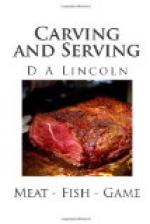Cantaloupes, if small, are sometimes served cut in halves. If large, divide from end to end in nature’s lines of depression.
THE THICKNESS OF SLICES.
By “very thin slices of meat” we mean slices less than an eighth of an inch thick.
“Thin slices” are from one eighth of an inch to three sixteenths of an inch in thickness.
Slices of “medium thickness” are one quarter of an inch.
Bread for dinner should be cut in slices one inch and a half thick, and each slice should be divided across into three or four long pieces, according to the width of the slice.
For tea, cut slices three eighths of an inch thick, and for toast, one quarter of an inch.
Thick loaves of cake should be cut in slices from three fourths of an inch to an inch thick, and divided once. Cut loaves of medium thickness in pieces as broad as the cake is thick, and divide them once. Thin sheets of cake should be cut in rectangular pieces twice as broad as the cake is thick. Then divide once, or even twice, if the sheet be very wide. Layer cakes baked in round pans are usually divided into triangular pieces; but they are less suggestive of baker’s Washington pie, which is so offensively common, if the edges be trimmed in such a way as to leave a square. Then cut this square into smaller squares or rectangles.
UTENSILS FOR CARVING AND SERVING.
In any first-class cutlery store you will find knives for each special kind of carving. If your purse will permit the indulgence, it will be convenient to have a breakfast-carver, a slicer, a jointer, a game-carver, and a pair of game-scissors. But if you can afford to have only one, you will find a medium-sized meat-carver the knife best adapted to all varieties of carving. The blade should be about nine inches long and one inch and a quarter wide, slightly curved, and tapering to a point.
The fork should have two slender curving tines about three eighths of an inch apart and two and a half inches long, and should have a guard.
A breakfast or steak carver is of the same general shape, but the handle is smaller, and the blade is six or seven inches long. A slicer for roasts has a wide, straight blade, twelve inches long, and rounded instead of pointed at the end. This is especially convenient for carving thin slices from any large roasts, or other varieties of solid meat. The width of the blade helps to steady the meat, and its great length enables one to cut with a single, long, smooth stroke through the entire surface. With a knife having a short blade a sort of sawing motion would be made, and the slice would be jagged. As there are no joints to separate, a point on the blade is unnecessary.
A jointer is another form of carver, useful where the joints are so large or so difficult to separate that considerable strength is required. The handle has a crook or guard on the end to enable the carver to grasp it more securely and use all the strength necessary.




